Enhydra fluctuans / হিলমেচিকা / হিঞ্চে।
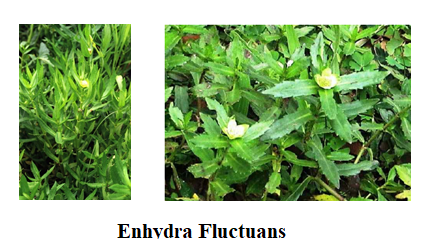
General features: It is an annual herbaceous edible tropical herb belonging to Asteraceae family, often used as vegetable green during cooking or salad, possessing slight bitter or no taste. The English or botanical name is Enhydra fluctuans (EF). It is a semiaquatic plant that normally grows in the aqueatic environment often mistakenly identified as Water cress / Helencha /হেলেঞ্চা, which belongs to Braceace family. In Bengali or Ayurveda, it is properly named as Hilmechika / হিলমেচিকা / হিঞ্চে।. The plant, EF grows all over the South East Asian regions particularly in Malay, Sri Lanka and eastern part of India and Australia which is thought to be its native land. It is a prostrate and tends to spread on the surface whose stems are fairly fleshy and enlarges to about 1.0 ft in length. It is somewhat branched and rooting at the lower nodes also fairly hairy by the nature. The leaves are linear oblong about 1.5 – 2.0 inches in length, usually pointed at the tip and truncated at base also toothed at margins. The flowering heads have no stalks and stood at the angle between stem and the leaves. The flowers are white and greenish or greenish-white in appearance and the fruits are achenes enclosed by strong receptacles. In most cases, either the leaves or young plants are used for edible reasons. It is also one of the necessary items belonging to the members of celebrated ‘Fourteen vegetable greens’ (Chodddo Shak / চোদ্দো শাক), consumed during the Diwali festival (Lighting festival) in India.
Folk medicinal uses: As indicated by Ayurveda, EF has been used to treat liver disorders, skin and nerve disorders. In India, juice made from the fresh EF leaves are used as a tonic or else treatment for neuralgia and other nerve disorders or even as a laxative. In other South East Asian nations like in Malay, the young leaves are consumed mainly for the laxative reason. In Philippines pastes made from the fresh leaves are applied to the skin for any eruptions or infections. It is also frequently applied to the female breasts to control the inflammation. In many rural areas it is used to cure gonorrhea. The paste prepared from leaves is often applied to the forehead for the remedy of headache or cooling the body in summer or even during the high fever.
Important chemical constituents in EF: Besides having the usual primary constituents like chlorophyll, starch, fibers and minerals, the plant is uniquely enriched with proteins and β – carotene. In addition, it possesses a large reserve of saponins and tannins. The other ingredients are Cholesterol, Myricyl alcohol, Sitosterol, Stigmasterol, glucosides, sesquiterpene lactones (Germacranolide, Enhydrin, and Fluctuanin) and few diterpenoid acids or their isovalerate or angelate derivatives. Other plant flavonoids like Gibberellins A9 and Gibberellins A13 are also isolated from the plant. Very minute level of alkaloids has been detected but none has been identified or characterized effectively.
The saponin found in EF has been analyzed to have the chemical structure shown below In general, saponins are known to have positive impact on health by lowering absorption of fats and lipids through the intestine subsequently reducing cholesterol and LDL level in circulation. Saponins also boost the immune system and helps maintain the normal body weight.
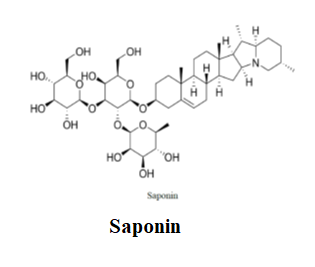
Myricyl alcohol or Tricontanol is along chain alcohol often synthesized within the plant. It acts as a growth stimulant to them.

β – Carotene is also an herbal product that helps produce vitamin – A by the enzyme cleavage. The enzymatic cleavage of one molecule of β – Carotene generates two molecules of Vitamin – A.

β – Sitosterol, the molecule is mainly synthesized within the plants. Although being phytosterol it acts a precursor to anabolic steroid Boldenone. β – Sitosterol has the property to reduce the level of circulating Cholesterol also enables to prevent or cure benign prostate hyperplasia (BPH).
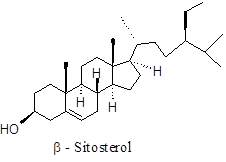
Stigmasterol is unsaturated phytosterols which is metabolized to Progesterone, Estrogen and Corticoids. Those are important steroids needed for normal physiological functioning.
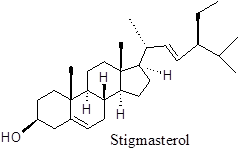
Gibberellins exist in different forms. They are plant growth hormones and diterpenoid acids by nature but not the flavonoids. Identification and characterization of bioactivity of Gibberellins brought the historic Green Revolution in the field of agriculture by boosting the food productions all over the world. It helps plant growth by breaking away the dormancy and enhancing the event of germination. It also catalyzes the breakdown of storage starch within seedlings at different stages producing glucose by inducing the enzyme α – Amylase which essentially causes rapid growth of the plant. Although few reports on animals indicate adverse health effects but nothing has been recorded about the human so far.
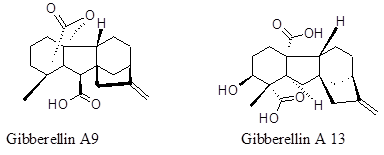
Germacrene lactones are widely known for their anti-mitotic and other biological actions acting against the tumor cells. The lactones have oxygen linking ring with carbonyl moiety at β position (O=C=CH2) in the following figures. The unsaturated Carbonyl (= C=O) follow Michael type addition reaction with any nucleophiles within biological components like – SH or amino acid cysteine. The alkylation of thiol group affects number of biological function. Besides their oxygen rich assembly, it also helps plants survival from various predators and microbes. The beneficial actions on human health are anti-inflammatory, anti-tumor and antibacterial or anti-parasitic / antimicrobial effects. In many of the cases the action is somewhat specific. The structures shown below are Fluctuans – Enhydrin, Fluctuanin, Fluctuadin and two chlorine containing compounds, Melampolides.
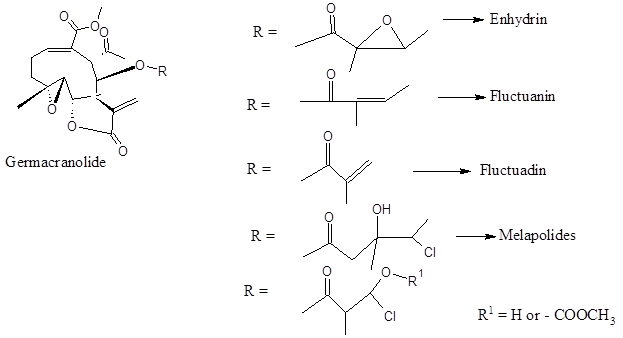
Baicalein is a bioactive flavone having versatile physiologic role. It often has the glycoside linkages. It is a positive modulator of Benzodiazepine site or non-benzodiazepine site of GABAA receptor inducing anxiolytic effect without causing sedation. It selectively works on the α2 and α3 subunit of GABAA receptor. It is recorded that Baicalein can impose anti-depression effect. It also acts as an estrogen antagonist. Further it inhibits lipoxygenases therefore can act as an anti-inflammatory agent. In addition, it blocks the ET-1 induced proliferation of pulmonary arterial smooth muscle cells.
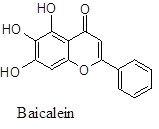
Mostly the hydrolysable tannins are noticed within EF which usually exert antioxidant effects as well as provides bitterness in taste without causing any significant de-proteinization within the physiologic system.
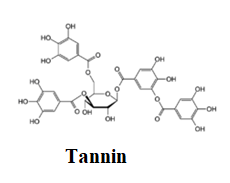
Pharmacological effects: The versatile uses of EF require to identify the mechanism behind its numerous pharmacological effects, which are seen to be beneficial for maintaining the normal health. Below is the list of few of them.
Anti-inflammatory effect – The experiments on laboratory animals following carrageenan induced paw edema or cotton pellet implanted granuloma indicated that extract of EF particularly the fraction enriched with flavonoids exhibits strong anti-inflammatory effect. The action is mediated via the inhibition of enzymes COX – 2 and 5 – LOX. The isolation of flavonoids eg, Baicalein is identified to block the metabolism of Arachidonic acid cascade subsequently exerting the anti-inflammatory role.
Antioxidant effect – The various extracts of EF show strong antioxidant actions when tested in different ways. The antioxidant property of EF is widely known. The extraction by ethyl alcohol shows the highest free radical scavenging ability that includes NO and super oxide and others. The presence of flavonoids and tannins could be liable behind this act.
Anthelmintic effect – The alcoholic extract of EF shows strong anthelmintic effect, which is vary comparable to the drug, Albendazole which works by binding to the colchicine interacting site of β – tubulin inhibiting the polymerization of microtubules but uniquely having more affinity toward β – tubulin of the parasites subsequently preventing the formation of spindle fiber essential during cell division. But the exact mechanism in case of EF is not yet revealed. It is speculated that possibly by inhibiting spindle fiber formation inside the worm needed for the cell division it eventually causes dysfunction and death to the parasites.
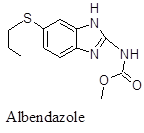
Anti-clotting activity – It has been widely known that thrombolysis works by modulating the enzyme, plasminogen which works by dissolving the fibrin clot leading to solubilize and implicating its further proteolysis. But in that concern, the action of EF could be somewhat different. It is speculated that presence of numerous phytocomponents is in some way responsible for its thrombolytic behavior, but none are specifically identified neither the mode of action although the action is seen dose-dependent.
Antidiarrheal effect – Either the methanolic or aqueous extract can perform antidiarrheal activity on castor oil induced diarrhea. Further investigations indicate that aqueous extract inhibits / prevents the growth of S. aureus, S. dysenteriae and S. boydii whereas the methanolic extract partially inhibits S. flexneri, S. dysenteriae and S. boydii.
Hepatoprotective effect – The experiments on laboratory animal model using CCl4 induced oxidative damage has shown that Ethyl acetate extract of EF, largely enriched with flavonoids offer significant hepatic protection by elevating the level of antioxidant enzymes with subsequent inhibition of lipid peroxidation.
Anticancer effect – The specific flavonoid fraction was tested for anticancer activity against Ehrlich’s ascites carcinoma in Swiss albino mice. The flavonoid glycosides of Baicalein (Baicalein – 7 – O-glucoside and Baicalein – 7 – O – di-glucoside) are identified to provide durable anticancer / antitumor actions reducing significantly tumor volume as well as enhancing the life span of experimental animals.
Miscellaneous actions – A) Phagocytic and cytotoxic activity, B) Neuroprotective potential, C) CNS depression action, D) Analgesic activity, E) Antidiabetic activity.
